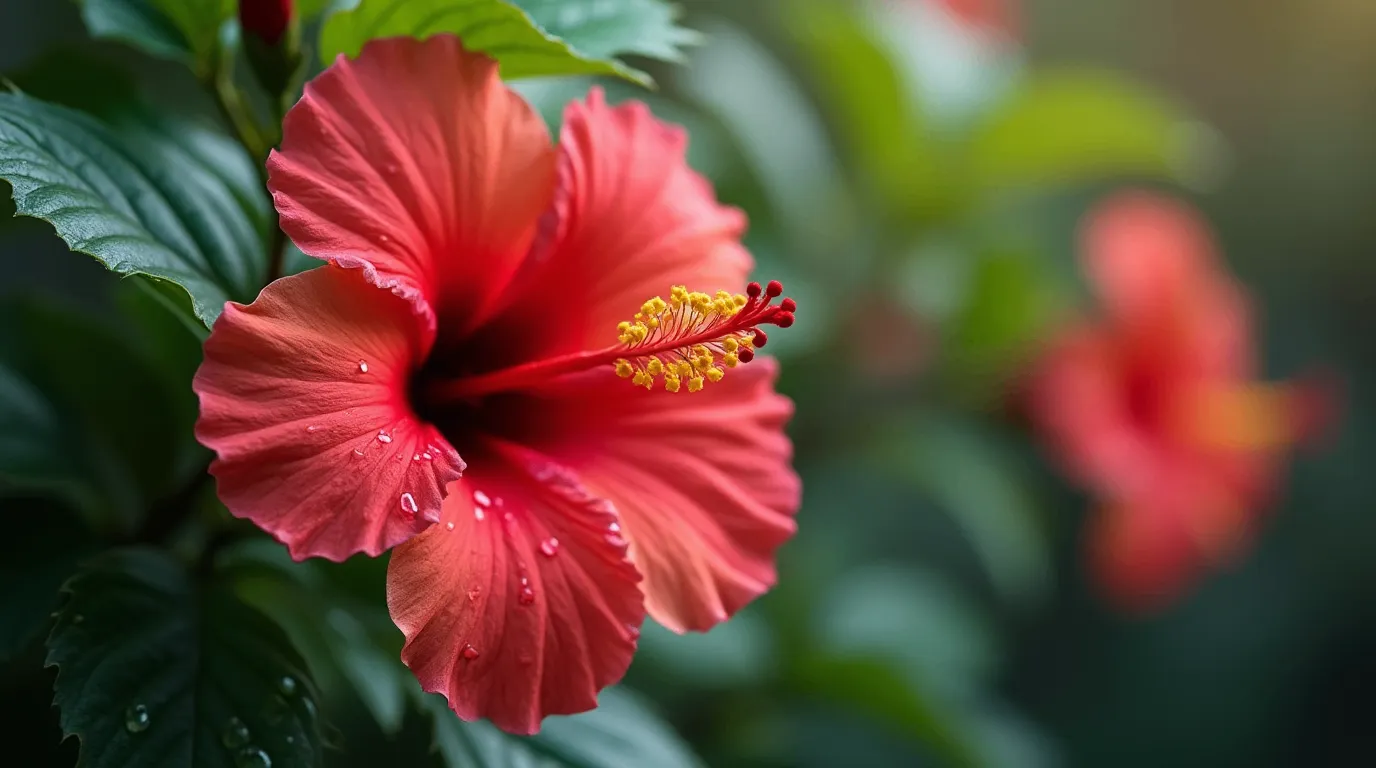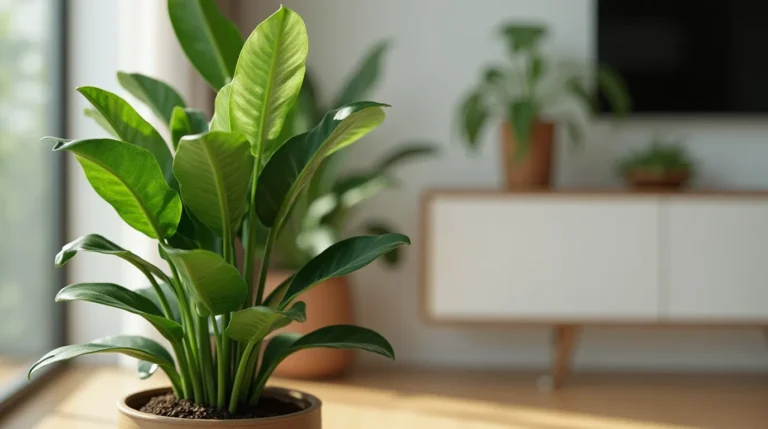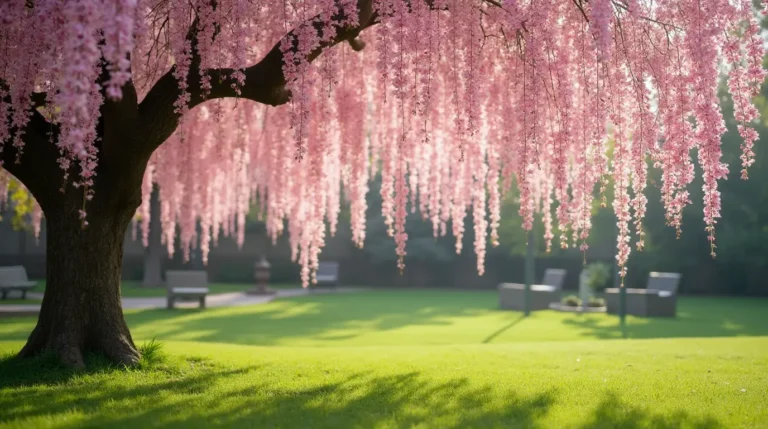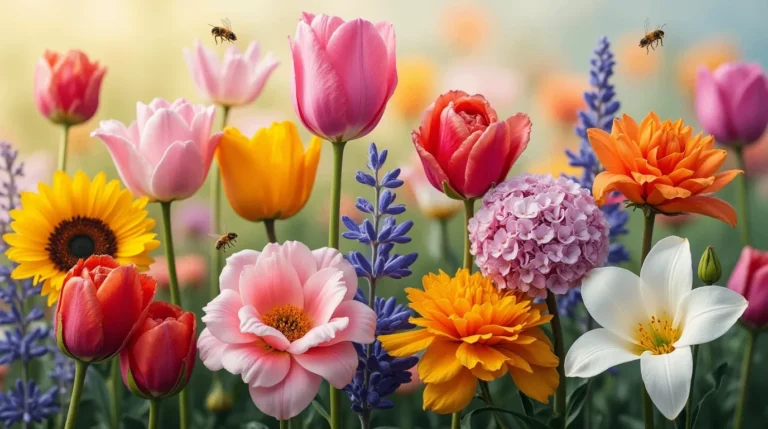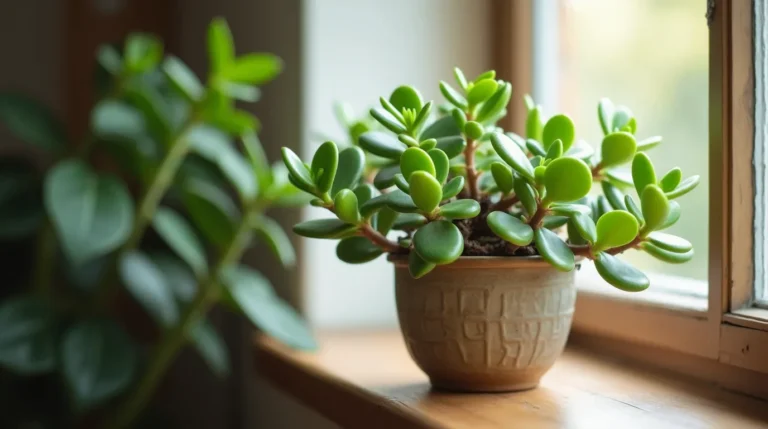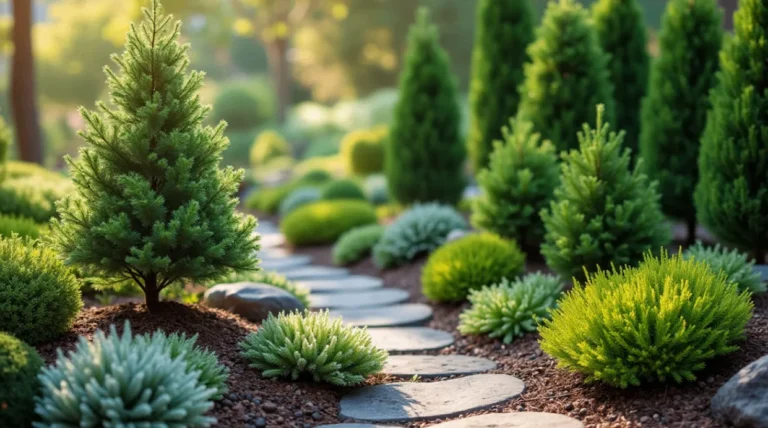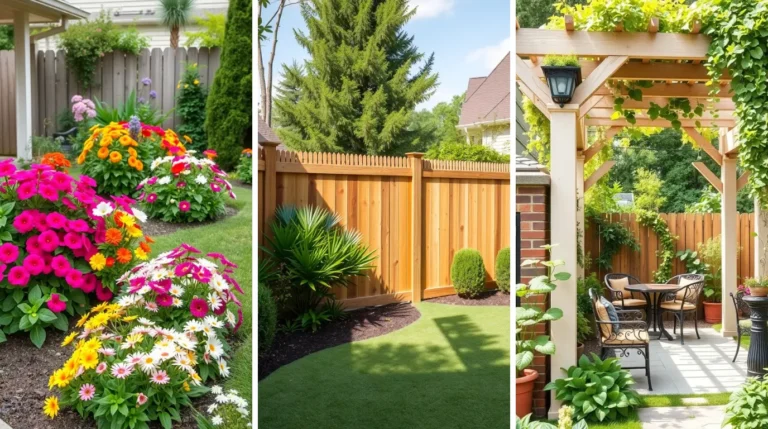Hibiscus Propagation: How to Grow New Plants Easily
The hibiscus plant is a stunning addition to any garden. Its vibrant flowers attract attention and admiration. Propagating hibiscus plants is rewarding, allowing you to share these beautiful plants with friends and family or expand your garden. With the right techniques, growing new hibiscus plants can be easy and enjoyable.
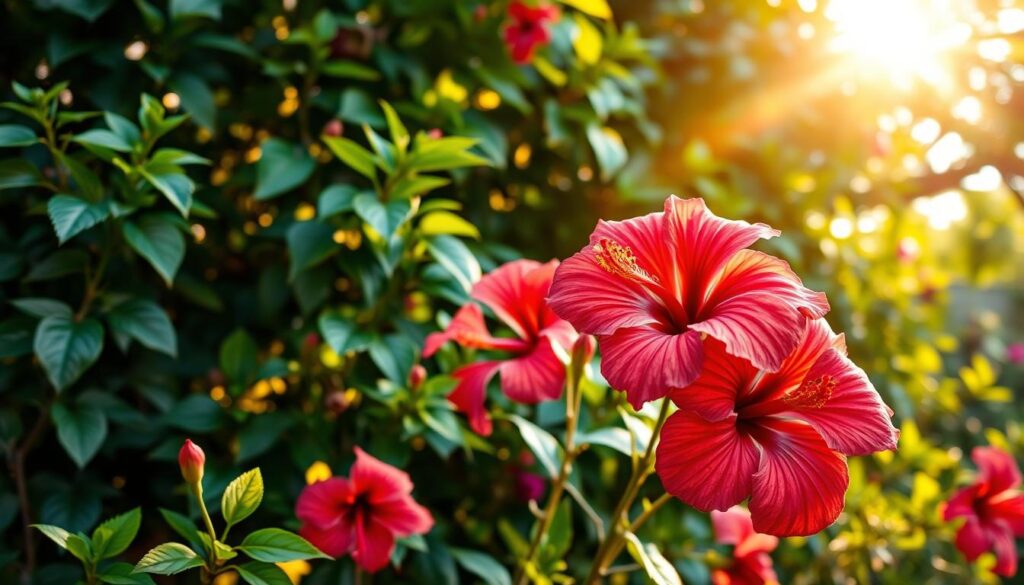
Whether you’re a seasoned gardener or just starting out, propagating hibiscus plants is a great way to explore the world of hibiscus. It lets you discover the joy of growing your own plants. By learning how to propagate hibiscus, you’ll enjoy the beauty of hibiscus flowers in your garden and share your knowledge with others.
Introduction to Hibiscus Propagation
Propagating hibiscus plants is simple and effective. With the right guidance, you can achieve great results. In this guide, we’ll cover the basics of hibiscus propagation, including the best techniques and tips for success.
Key Takeaways
- Propagating hibiscus plants is a rewarding experience that allows you to share beautiful plants with others.
- Hibiscus flowers are a stunning addition to any garden, attracting attention and admiration.
- With the right techniques, growing new hibiscus plants can be easy and enjoyable.
- Propagating hibiscus plants is a great way to explore the world of hibiscus and discover the joy of growing your own plants.
- By learning how to propagate hibiscus, you’ll be able to enjoy the beauty of hibiscus flowers in your garden.
- Propagating hibiscus plants is a simple and effective way to grow new plants.
Understanding the Beautiful Hibiscus Plant
The hibiscus plant is a stunning addition to any garden. It has vibrant colors and delicate petals. The yellow hibiscus is especially popular for its bright blooms.
To keep these plants thriving, understanding hibiscus care is key. They need plenty of sunlight, water, and nutrients. By providing the right conditions, you can enjoy your hibiscus plant for months.
Different Varieties of Hibiscus
There are many varieties of hibiscus plants. Each has its own unique characteristics and growth habits. Popular varieties include tropical, hardy, and dwarf hibiscus.
Choosing the right variety for your climate and garden is important. This way, you can enjoy these plants year-round.
Why Propagate Hibiscus Plants
Propagating hibiscus plants is a great way to share them with others. By taking cuttings from a healthy plant, you can grow new ones. This process also helps ensure the new plants are healthy and disease-free.
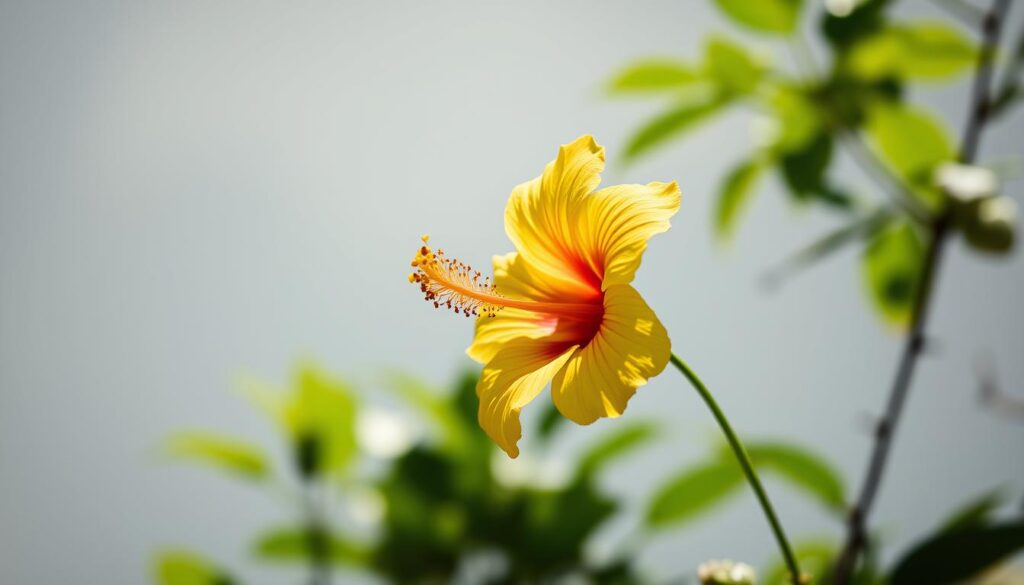
Best Time for Propagation
The best time to propagate hibiscus plants varies by variety and climate. Generally, spring and summer are best. The warm and sunny weather helps your new plants thrive.
| Variety | Propagation Method | Best Time |
|---|---|---|
| Tropical Hibiscus | Cuttings | Spring |
| Hardy Hibiscus | Division | Fall |
| Dwarf Hibiscus | Layering | Summer |
Essential Tools and Materials for Propagation
To successfully propagate a pink hibiscus, you need the right tools and materials. This includes high-quality pots, soil, water, and fertilizers. Using the correct materials ensures your pink hibiscus gets the best care.
Some of the essential tools and materials you’ll need for propagation are:
- Pots with good drainage to prevent waterlogged soil
- A well-draining potting mix specifically designed for tropical plants like the pink hibiscus
- Water that is free of chlorine and other chemicals
- A balanced fertilizer to promote healthy growth
When selecting materials, consider your pink hibiscus’s specific needs. For example, high-quality soil is crucial for your plant’s health and growth. By investing in the right tools and materials, you’ll be well on your way to successfully propagating your pink hibiscus.
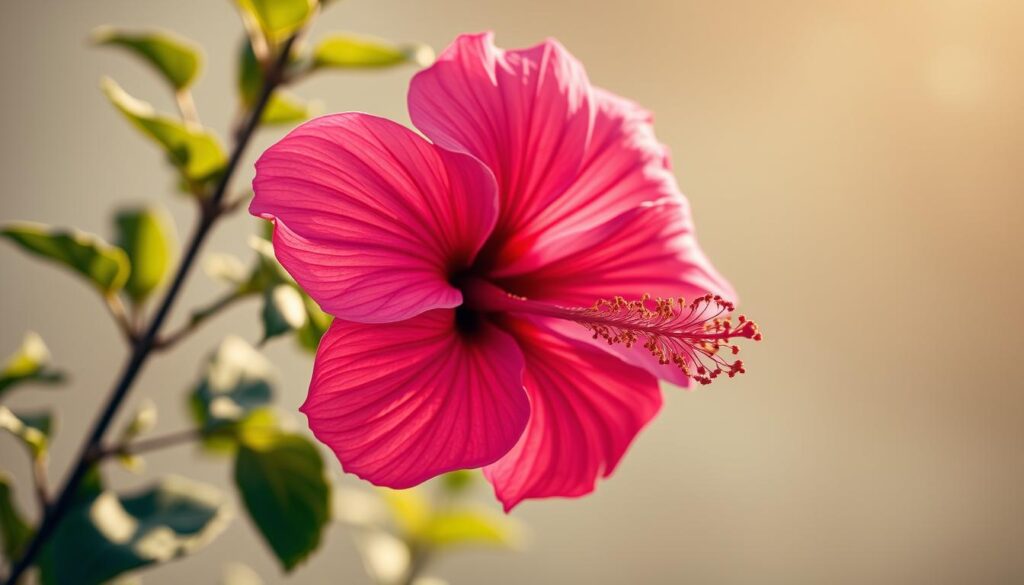
Remember, the key to successful propagation is to provide your pink hibiscus with the right environment and care. By using the essential tools and materials outlined above, you’ll be able to give your plant the best chance to thrive.
Propagating Hibiscus from Cuttings
Many gardeners choose to grow new hibiscus plants from cuttings. This method is especially good for red hibiscus varieties. It lets gardeners share their favorite plants with others. First, pick healthy cuttings from a mature plant.
Selecting Healthy Cuttings
Choose stems with at least two nodes for better rooting success. The best time for cuttings is spring or summer when the plant is growing fast. For a red hibiscus, pick cuttings with bright green leaves and strong stems.
Preparing the Growing Medium
A good potting mix is key for successful propagation. Use a mix made for cuttings or seedlings for the right moisture and air. Hibiscus plants do well in slightly acidic soil.
Steps for Successful Cutting Propagation
To grow a hibiscus from a cutting, follow these steps:
- Take a 4-6 inch cutting from a healthy stem, just above a node.
- Remove the lower leaves, keeping only the top two or three sets intact.
- Immerse the cut end in rooting hormone powder or liquid.
- Plant the cutting in the prepared growing medium, firming the soil gently around the stem.
- Water thoroughly and provide bright, indirect light.
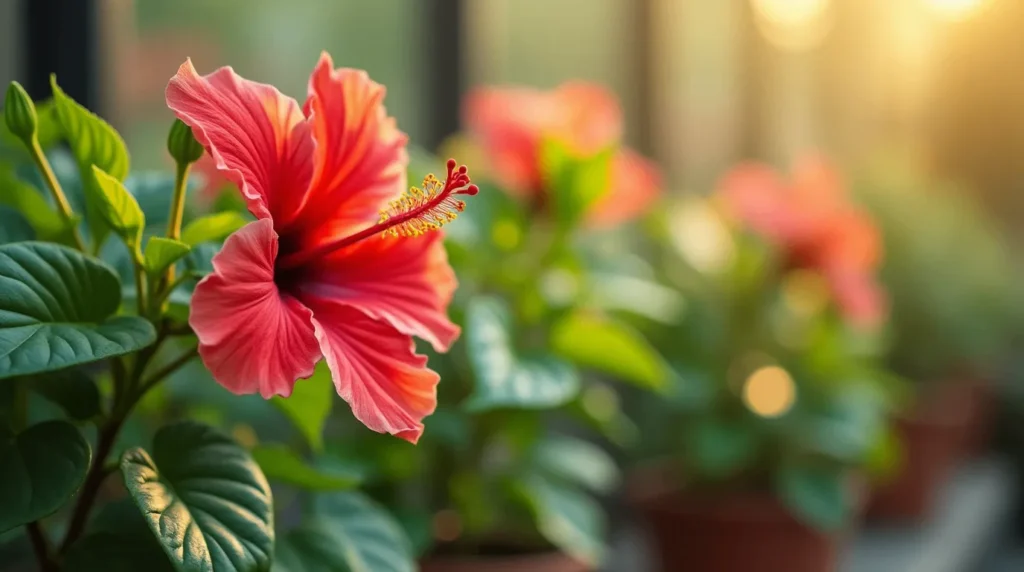
With the right care and patience, a hibiscus cutting can grow into a beautiful plant. It will produce stunning flowers, like the red hibiscus. By following these steps and creating the right conditions, gardeners can successfully grow their favorite hibiscus varieties.
| Hibiscus Variety | Propagation Method | Success Rate |
|---|---|---|
| Red Hibiscus | Stem Cuttings | 80-90% |
| Tropical Hibiscus | Stem Cuttings | 70-80% |
Growing Hibiscus from Seeds
Growing hibiscus flowers from seeds can be very rewarding. It lets you see the whole life of the plant, from seed to bloom. With the right hibiscus care, seeds can turn into beautiful, flowering plants.
First, pick high-quality seeds from a trusted source. Make sure the seeds match your climate and the type of hibiscus flowers you want. Popular types include tropical, hardy, and dwarf hibiscus.
Here are some tips for growing hibiscus flowers from seeds:
- Plant seeds in well-draining soil with a temperature of around 75-85°F (24-29°C).
- Keep the soil consistently moist but not waterlogged.
- Provide indirect sunlight and maintain a humid environment.
With the right hibiscus care, seeds will germinate in 1-3 weeks. Once they have 2-3 sets of leaves, move them to individual pots. Keep the growing conditions perfect, and your hibiscus flowers will bloom in 3-6 months.
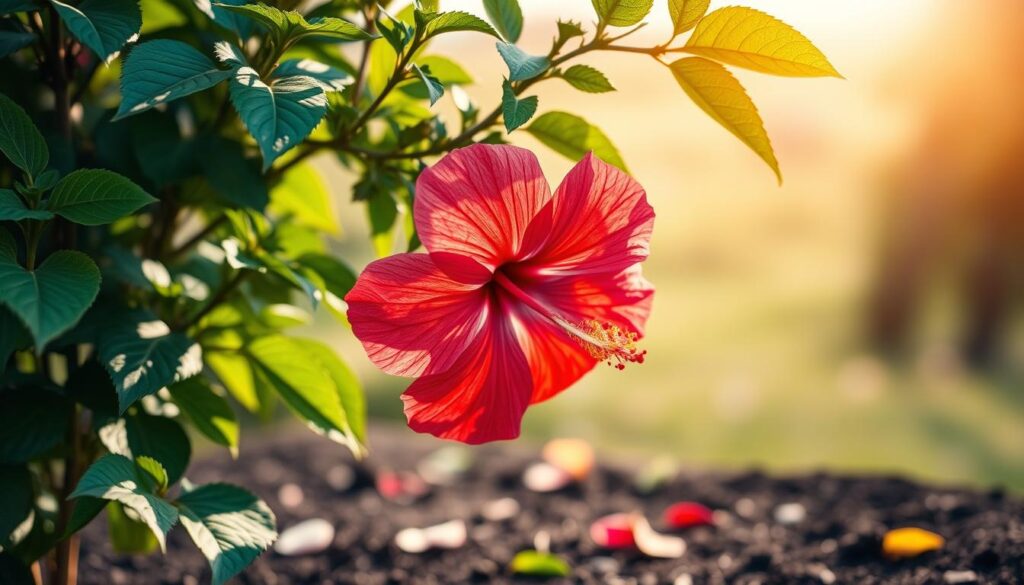
By following these tips and giving your hibiscus flowers the right care, you can enjoy their beauty and scent in your garden or indoors.
| Variety | Seed Germination Time | Bloom Time |
|---|---|---|
| Tropical Hibiscus | 1-2 weeks | 3-6 months |
| Hardy Hibiscus | 2-3 weeks | 4-7 months |
| Dwarf Hibiscus | 1-2 weeks | 2-5 months |
Water Propagation Methods
Water propagation is a cool way to grow hibiscus plants, like the yellow and pink varieties. It roots plant cuttings in water, showing how roots grow. First, pick a container that fits the cutting and water.
Container Selection
A clear glass or plastic container works best. It lets you see the roots grow. Make sure it’s clean and filled with fresh, warm water. Keep the water level below the node to avoid rot.
Water Quality Requirements
Using the right water is key. Distilled or filtered water is best, as tap water can harm roots. Change the water often to keep it clean and prevent bacteria.
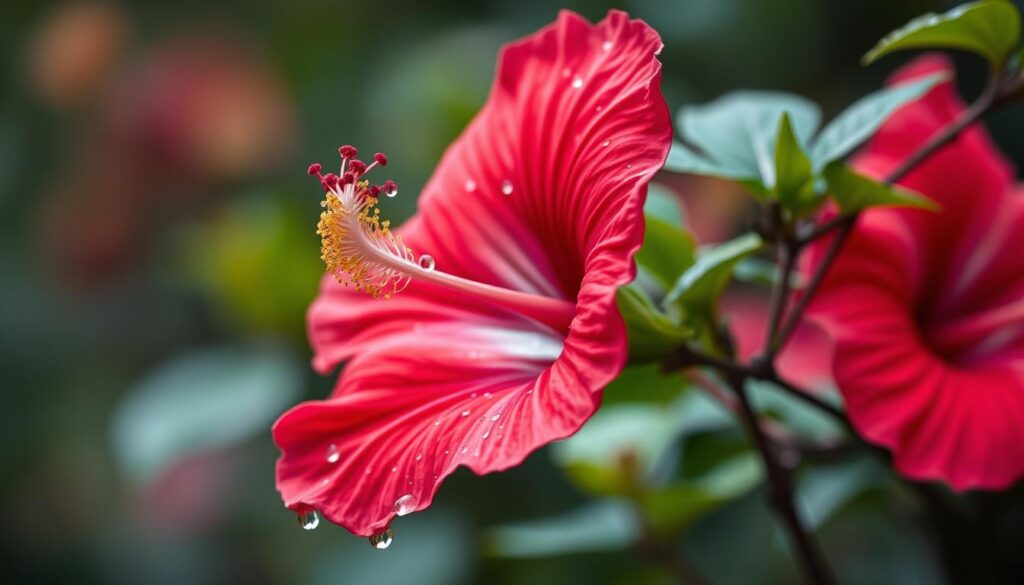
Monitoring Root Development
Watching your plant’s roots grow is important. Roots start to show in 1-2 weeks. This tells you when it’s time to move the cutting to soil. A strong root system means a healthy plant.
| Plant Variety | Root Development Time | Transplantation |
|---|---|---|
| Yellow Hibiscus | 1-2 weeks | After 2-3 weeks of root development |
| Pink Hibiscus | 1-2 weeks | After 2-3 weeks of root development |
Soil Requirements for New Hibiscus Plants
For healthy hibiscus plants, the right soil is key. The best mix includes organic matter, perlite, and vermiculite. This blend keeps the soil moist, drains well, and avoids waterlogging.
A balanced soil pH is also vital. Aim for a slightly acidic to neutral range, between 6.0 and 7.0. Adding compost or well-rotted manure can help. Here are important tips for soil preparation:
- Choose a high-quality potting mix for tropical plants like hibiscus.
- Apply a 2-inch layer of organic mulch to keep moisture in and weeds out.
- Check the soil pH often and adjust it if needed for the best growth.
By following these steps and using the right soil mix, you’ll create a perfect spot for your hibiscus flowers. Don’t forget to water and fertilize them regularly. This will help them grow strong and bloom beautifully.
Light and Temperature Conditions
Understanding the right light and temperature for a healthy red hibiscus is key. Hibiscus plants love warm temperatures and bright light. But, the exact needs can change based on where you are.
In homes, hibiscus plants need enough light to grow. You can place them by sunny windows or use grow lights. The best indoor temperature is between 65-95°F (18-35°C). A bit cooler at night helps them grow well.
Indoor Light Requirements
Hibiscus plants need 4-6 hours of direct sunlight daily. If direct sunlight is hard, use extra lights to help with photosynthesis.
Outdoor Growing Conditions
Outside, hibiscus plants like full sun to partial shade, depending on where you live. In hot places, they need some shade to avoid leaf burn. The best outdoor temperature is 60-100°F (15-38°C). Keep them safe from very cold or hot weather.
Temperature Management
It’s important to keep the temperature steady for your hibiscus. Use insulation, shade, or bring it inside when it’s too hot or cold. Following these tips helps your red hibiscus grow well and look beautiful.
Knowing your hibiscus’s light and temperature needs is crucial for its health. Always check local advice for the best care in your area. This ensures your red hibiscus gets the best care possible.
| Lighting Conditions | Temperature Range |
|---|---|
| Indoor: 4-6 hours direct sunlight | 65-95°F (18-35°C) |
| Outdoor: Full sun to partial shade | 60-100°F (15-38°C) |
Watering and Humidity Needs
Proper watering and humidity levels are key for hibiscus plants. The yellow hibiscus needs a balanced environment to grow well. Be careful not to overwater, as it can lead to root rot and other problems.
Water your hibiscus when the top inch of soil becomes dry to the touch. This is usually every 2-3 days in summer and less in winter. Make sure the soil drains well to avoid waterlogging.
- Check the soil moisture by inserting your finger into the soil up to your first knuckle.
- Water deeply, ensuring proper drainage to prevent soil from becoming waterlogged.
- Humidity levels should be maintained between 50-70% to promote healthy growth and prevent pests.
To keep the humidity right, place the yellow hibiscus on a tray with water and pebbles. Or use a humidifier. This creates a microclimate that meets the plant’s needs.
By following these tips, you can give your hibiscus the right water and humidity. This will help them grow healthy and bloom beautifully.
| Plant Type | Watering Frequency | Humidity Level |
|---|---|---|
| Yellow Hibiscus | Every 2-3 days | 50-70% |
| Other Hibiscus Varieties | Every 3-4 days | 40-60% |
Fertilization Guidelines for Young Plants
Fertilizing young hibiscus plants is key for their growth and blooms. Pink hibiscus flowers need a balanced diet to bloom well. A good fertilization plan can greatly improve their health and look.
There are many fertilizers to choose from for young hibiscus plants. Organic fertilizers are a favorite because they’re good for the environment and soil. Examples include compost, manure, and fish emulsion.
Types of Fertilizers
- Organic fertilizers: compost, manure, fish emulsion
- Inorganic fertilizers: synthetic fertilizers, such as 10-10-10 NPK
- Specialty fertilizers: bloom boosters, micronutrient supplements
Application Schedule
Fertilize young hibiscus plants every 2-3 weeks when they’re growing. The exact schedule and type of fertilizer depend on the plant’s needs. Always follow the package instructions and start with a small amount to avoid harming the roots.
By following these guidelines, your young hibiscus plants will grow strong and healthy. They will produce lots of beautiful flowers, including the gorgeous pink hibiscus.
| Fertilizer Type | Application Frequency | Recommended Dosage |
|---|---|---|
| Organic fertilizer | Every 2-3 weeks | 1-2 tablespoons per gallon of water |
| Inorganic fertilizer | Every 4-6 weeks | 1/2 to 1 teaspoon per gallon of water |
Common Problems During Propagation
When you’re growing hibiscus plants, like the stunning red hibiscus, you need to know about common issues. Taking good care of your plants is key to avoiding problems like root rot, pests, and not getting enough nutrients. These problems can really hurt your chances of success.
It’s important to keep a close eye on your plants. Look out for:
- Root rot, often caused by too much water
- Pests, such as aphids or whiteflies, which can be controlled with insecticidal soap
- Nutrient deficiencies, which can be fixed with balanced fertilizers
To avoid these problems, make sure your plants have good airflow. Use soil that drains well and water them right. By following the right hibiscus care steps, you can lower the chance of these issues. This will help you grow your red hibiscus plants successfully.
| Problem | Cause | Solution |
|---|---|---|
| Root Rot | Overwatering | Improve drainage, reduce watering frequency |
| Pests | Infestation | Use insecticidal soap, introduce beneficial insects |
| Nutrient Deficiencies | Imbalanced fertilization | Use balanced fertilizer, monitor plant response |
Transplanting Your New Hibiscus
Transplanting a hibiscus plant is a key step for its health and beauty. It’s important to choose the right time and prepare the plant well to avoid shock.
Transplanting means moving the plant to a bigger container. This gives the roots more space to grow. It’s essential for the plant to get enough nutrients and water to bloom.
Timing the Transplant
The best time to transplant is when the plant has outgrown its pot. Check this by gently removing the plant and looking at the roots.
Proper Planting Techniques
To transplant successfully, follow these steps:
- Choose a container that is at least 1-2 sizes larger than the original one
- Use a well-draining potting mix to prevent soil from becoming waterlogged.
- Gently handle the roots to avoid damage or disruption.
- After transplanting, water thoroughly to help the soil settle.
By following these tips and caring for your hibiscus, it will thrive. It will then produce beautiful flowers for many years.
| Transplanting Tips | Benefits |
|---|---|
| Transplant in the morning or evening | Reduces stress on the plant |
| Water thoroughly after transplanting | Helps settle the soil and establish roots |
| Provide sufficient light and nutrients | Supports healthy growth and flower production |
Pruning and Training Young Plants
Pruning and training are key for young hibiscus plants, like the yellow hibiscus. They help the plant grow well, bloom more, and look the way you want. When you prune, you remove dead or damaged parts. This stops disease and makes the plant grow new.
To prune your young hibiscus, start by cutting off weak or spindly parts. This helps the plant focus on growing strong stems and leaves. You can also shape the plant to grow upright or spread out, depending on what you like. Here’s how to prune your yellow hibiscus:
- Remove any dead or damaged leaves or stems
- Cut back weak or spindly growth to encourage strong, healthy stems
- Prune to control the shape of the plant, encouraging it to grow upright or spread out
Proper pruning and training are vital for hibiscus care. They help your young plant become strong, healthy, and stunning. With the right light, water, and nutrients, your yellow hibiscus will be a joy to watch for years.
Disease Prevention in New Growth
When new hibiscus growth appears, it’s key to guard against diseases. Both pink and red hibiscus types face threats from fungi and pests. To keep them safe, using fungicides and pest control is vital.
Hibiscus plants can get root rot, leaf spot, and powdery mildew. These problems often come from too much water, bad air flow, or too much humidity. To avoid these, give your plants good drainage, enough air, and the right amount of water.
Common Diseases
- Root rot: caused by overwatering and poor drainage
- Leaf spot: caused by fungal infections and high humidity
- Powdery mildew: caused by poor air circulation and high humidity
Preventive Measures
To shield your pink and red hibiscus from diseases, take these steps:
- Use fungicides to prevent fungal infections
- Implement pest control methods to prevent infestations
- Provide well-draining soil and adequate air circulation
- Water plants properly, avoiding overwatering and underwatering
By taking these steps, you can safeguard your hibiscus from diseases. This ensures they grow strong and healthy. Keeping a close eye on your plants and regular care are crucial for their well-being.
| Disease | Cause | Preventive Measure |
|---|---|---|
| Root rot | Overwatering and poor drainage | Use well-draining soil and avoid overwatering |
| Leaf spot | Fungal infections and high humidity | Use fungicides and provide adequate air circulation |
| Powdery mildew | Poor air circulation and high humidity | Provide adequate air circulation and use fungicides |
Special Care Tips for Different Varieties
Each hibiscus variety has its own needs. To make sure your hibiscus flowers look great, you need to give them special care. Here are some tips to help you:
Tropical hibiscus varieties need lots of sunlight and warm weather. Hardier hibiscus types do well in cooler weather and partial shade. Also, some hibiscus types get pests and diseases easily, so watch them closely.
- Water your hibiscus plants often, but don’t overdo it to avoid root rot.
- Feed your hibiscus plants with a balanced fertilizer when they’re growing.
- Trim your hibiscus plants often to keep them healthy and blooming.
By following these tips, your hibiscus flowers will bloom beautifully and last for a long time. Always check what your hibiscus variety needs for the best care.
With the right care, your hibiscus plants will give you gorgeous hibiscus flowers. They’ll make your garden or indoor space look beautiful and elegant.
| Variety | Sunlight Requirements | Temperature Requirements |
|---|---|---|
| Tropical Hibiscus | Full sun | Warm temperatures (above 64°F) |
| Hardy Hibiscus | Partial shade | Cooler temperatures (below 64°F) |
Conclusion: Growing Your Hibiscus Family
Starting your hibiscus journey is exciting. With patience and the right steps, you can grow a beautiful hibiscus family. Enjoy watching the classic red hibiscus or the bright yellow and pink ones bloom.
This guide will help you grow new hibiscus plants. You’ll learn how to pick the best cuttings and create the perfect growing conditions. Each step is important for your plants to flourish.
Embrace the beauty of hibiscus care. Try different varieties and enjoy their stunning beauty. With the right knowledge, you can make your backyard or indoor space a vibrant hibiscus oasis.
FAQ
What are the different varieties of hibiscus flowers?
Hibiscus plants come in many varieties. You can find yellow, pink, and red hibiscus, each with its own look and care needs.
Why should I propagate hibiscus plants?
Propagating hibiscus plants is rewarding. It lets you grow new plants easily and share them with others. It’s a fun way to grow more of these beautiful flowers.
What is the best time of year to propagate hibiscus?
Spring and summer are the best times to propagate hibiscus. The plant is growing well, and the weather is warm and sunny.
What tools and materials do I need for hibiscus propagation?
You’ll need sharp pruning shears, pots, and well-draining potting soil. Rooting hormones and a warm, humid place are also important.
How do I propagate hibiscus from cuttings?
Choose healthy stems for cuttings. Prepare the soil, dip the cuttings in rooting hormone, and plant them. Keep the soil moist and warm until roots grow.
Can I grow hibiscus from seeds?
Yes, growing hibiscus from seeds is possible. It takes more time and effort but can introduce new varieties to your collection.
What type of soil do hibiscus plants prefer?
Hibiscus plants like well-draining, rich soil that’s slightly acidic. A mix of compost, peat moss, and perlite is ideal.
What light and temperature conditions do hibiscus plants need?
Hibiscus plants need full sun, 6-8 hours a day. They prefer warm temperatures, 65-85°F, and should avoid frost and cold drafts.
How much water and humidity do hibiscus plants need?
Hibiscus plants like moist, well-draining soil and high humidity. Water them often but avoid waterlogged soil. Use misting or a pebble tray for humidity.
How do I fertilize my young hibiscus plants?
Use a balanced, water-soluble fertilizer for young hibiscus. Follow the instructions on the label. Increase the frequency and amount as the plant grows.
What are some common problems I may face during hibiscus propagation?
Problems like root rot, pests, nutrient deficiencies, and poor root development can occur. Watch for these and take steps to prevent them.
When should I transplant my new hibiscus plants?
Transplant in spring or early summer when the plant is growing. Prepare the new site well and transplant carefully to avoid shock.
How do I prune and train my young hibiscus plants?
Prune and train regularly for healthy growth. Remove dead or damaged parts and shape the plant to encourage more growth and flowers.
How can I prevent diseases in my new hibiscus plants?
Prevent diseases by keeping things clean, using fungicides or insecticides as needed, and providing good growing conditions. Check your plants often for pests or diseases.
Are there any special care tips for different hibiscus varieties?
Yes, different hibiscus varieties have unique needs. Research the specific needs of your varieties to give them the best care.

